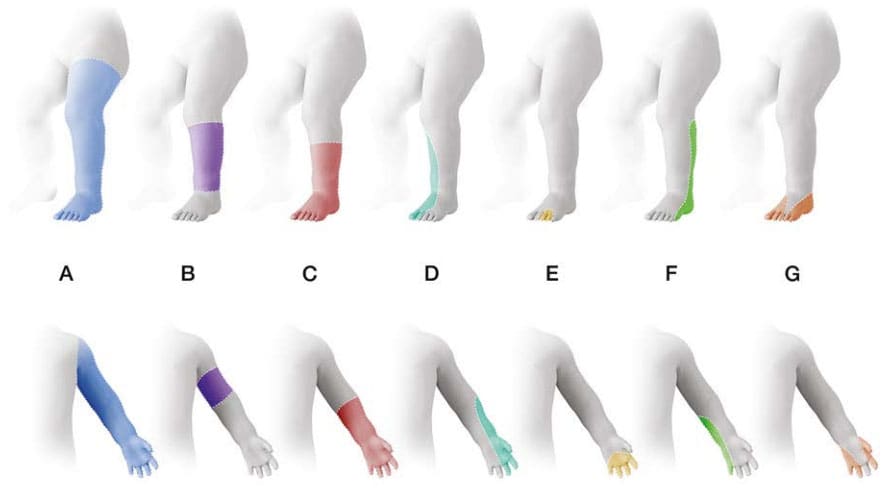Limb Reduction Defects/Limb Deficiencies
The key finding in limb reduction defects – also known as limb deficiencies – is the absence or severe hypoplasia of a limb or part of a limb. Severe hypoplasia is operationally defined as hypoplasia (small size) associated with abnormal shape.
Limb reduction defects need to be kept separate from other limb anomalies such as mild hypoplasia (with normal shape), syndactyly, or sirenomelia.
Hypoplasia with relatively normal shape is seen in many skeletal dysplasias, such as achondroplasia. Skeletal dysplasias are typically single-gene disorders and are not included among limb deficiencies in public health surveillance.
Other examples of mild hypoplasia with normal shape, to be distinguished from limb reduction defects, are: brachydactyly (without severe hypoplasia or absent bones of hand or feet) and clinodactyly (incurving of the finger, most commonly the fifth finger, due to hypoplasia of middle phalanx). Usually, mild hypoplasia does not require treatment and should be regarded as a minor anomaly.
Syndactyly with severe hypoplasia of phalanges should be excluded. Sirenomelia is a severe sequence with fusion of lower limbs and visceral anomalies. Sirenomelia should not be included among limb deficiencies. The standard nomenclature divides limb deficiencies into two basic types – longitudinal and transverse. Longitudinal deficiencies are along the long axis of the limb and are distinguished into further subgroups: preaxial (radial and tibial side), postaxial (ulnar and fibular side) and axial (central). In contrast, transverse deficiencies occur across (transversally to) the long axis of the limb. Transverse defects may be terminal (more frequent) when the terminal part of the limb is completely missing; or intercalary when some part of the limb is missing but the terminal part is present, even if malformed. It is important to categorize limb reduction defects in the correct specific subtypes as these subtypes tend to differ by etiology and pathogenesis (see Table 1 and Fig. 35).
Table 1. Types of limb deficiencies by axis and segment involved
| Axis of the limb | Segment | Involvement |
| Complete absence | All segments | Amelia |
| Intercalary | Absence or severe hypoplasia of part of limb with normal or nearly normal terminal segment, including: • typical and atypical intercalary defects • femoral hypoplasia. |
|
| Longitudinal | Preaxial | Radial, tibial, first digit/toe (with or without involvement of second digit/toe). |
| Axial | Hand/foot only: Third ray involved (with or without second and fourth ray). Includes typical split-hand/foot and split-hand/foot monodactyly type. |
|
| Postaxial | Fifth digits/toes (with or without fourth digit/toe involved). | |
| Mixed | Any other combination of two or more subtypes; for example, femoral-fibula-ulnar complex. |
Fig. 35. Types of limb deficiencies by axis and segment involved (see text for details)

Absent or hypoplastic structures are shaded. A: complete absence of limb (amelia); (B) intercalary defect; (C) terminal transverse defect; (D) longitudinal defect, preaxial; (E) longitudinal defect, central; (F) longitudinal defect, postaxial; (G) longitudinal, pre- and postaxial.
Adapted from: Gold NB, Westgate MN, Holmes LB. Anatomic and etiological classification of congenital limb deficiencies. Am J Med Genet A. 2011;155A(6):1225–35).
Note: Avoid old and imprecise terms such as ectrodactyly, meromelia, micromelia and hemimelia. Avoid what are now considered pejorative terms, such as phocomelia (for transverse intercalary defects) and lobster claw (for split hand/foot).